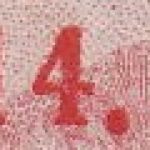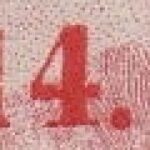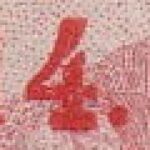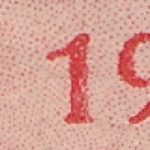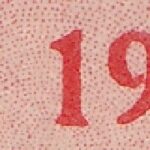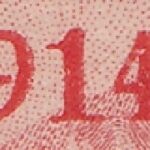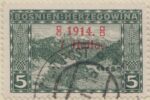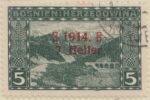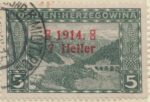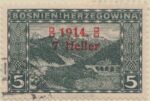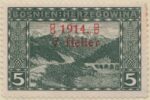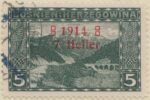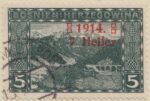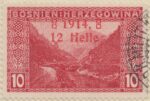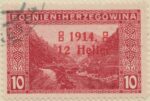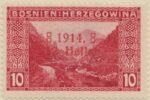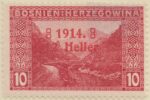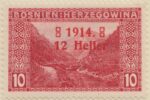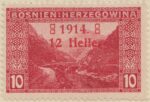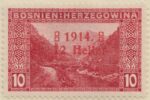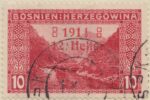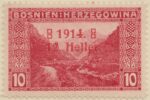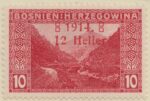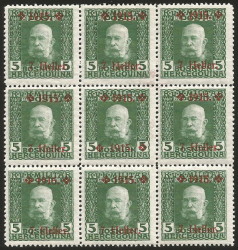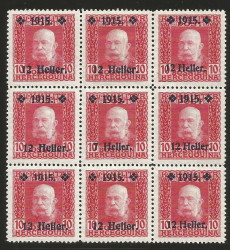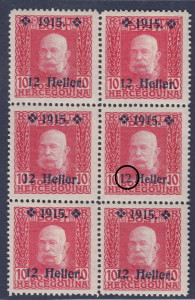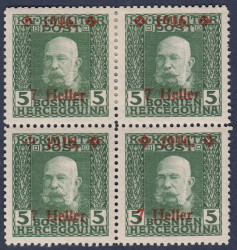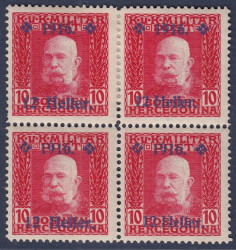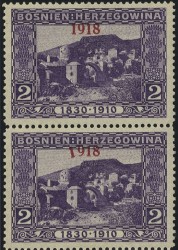Bosnia and Herzegovina: Austrian Rule
1 November 1906. Definitive issue: the scenery of Bosnia and Herzegovina and an effigy of Francis Joseph I. Printed in line engraving, paper grayish, gum white and thin. Stamps with brownish gum exist and are rare. Panes consist of 50 (10 x 5) stamps.
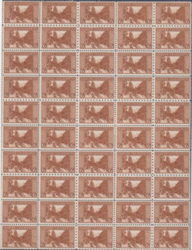 Multiple perforations applied within a single pane. |
Perforations
Stamps from this issue exist in many combinations of perforations. According to Fleck (1941: 49) it was first decided that the stamps should be perforated in line perforations 12½ and 9¼ but at the very start, the 6½ perforation was also being used. 10½ perforation was used later.
Parallel mixed perforations (parallel sides are the same perforated) are:
- 6½: 9¼ and the opposite,
- 6½: 12½ and the opposite,
- 9¼: 10½ and the opposite,
- 9¼: 12½ and the opposite,
- 12½: 10½ and the opposite,
Apart from these many combinations of multiple perforations exist. According to Fleck (1941: 49) there are 142 combinations. Imperforate, double perforated, and partially imperforate stamps also exist, vertically imperforate examples are rare.
| COINCIDENTAL VARIETIES | ||
|---|---|---|
| 1 | Double perforation. | 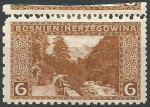 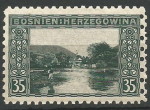 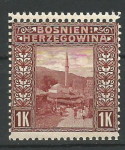 |
1 November 1914. The first war charity issue, stamps overprinted with the year mark 1914 in letterpress in red color. Printed in sheets of 50 (10 x 5).
| A. CONSTANT VARIETIES AND TYPES APPEARING ON BOTH VALUES | |||
|---|---|---|---|
| I |  |
The horizontal line in “H” is in the middle and the left vertical line is short. | |
| Field №: 35 | Pane: N/A | ||
| Other nomenclatures: – | |||
| Notes: also on the 10 heller stamp | |||
| Value €: – | |||
| II | 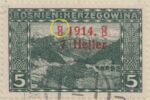 |
Indentation in the top left square. | |
| Field №: 2, 7 | Pane: N/A | ||
| Other nomenclatures: – | |||
| Notes: also on the 10 heller stamp. | |||
| Value €: – | |||
| III |  |
The second “1” is thin. | |
| Field №: 12 | Pane: N/A | ||
| Other nomenclatures: – | |||
| Notes: also on the 10 heller stamp | |||
| Value €: – | |||
| IV | 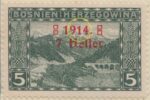 |
Second “1” is lowered. | |
| Field №: 14 | Pane: N/A | ||
| Other nomenclatures: – | |||
| Notes: on the 10 heller stamp is the distance between 1914. and 12 Heller wider (2 ¾ mm instead of 1 ¼ mm). | |||
| Value €: – | |||
| V | 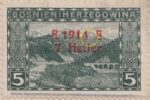 |
Deformed dot after 1914. | |
| Field №: 17 | Pane: N/A | ||
| Other nomenclatures: – | |||
| Notes: also on the 10 heller stamp. | |||
| Value €: – | |||
| VI |  |
The first “l” in “Heller” is thin. | |
| Field №: 23 | Pane: N/A | ||
| Other nomenclatures: – | |||
| Notes: also on the 10 heller stamp | |||
| Value €: – | |||
| VII |  |
Numeral 4 is damaged on the left. | |
| Field №: 26 | Pane: N/A | ||
| Other nomenclatures: – | |||
| Notes: also on 10 heller stamp. | |||
| Value €: – | |||
| VIII |  |
Damaged lower left square. | |
| Field №: 38 | Pane: N/A | ||
| Other nomenclatures: – | |||
| Notes: also on 10 heller stamp. Another example. | |||
| Value €: – | |||
| IX | 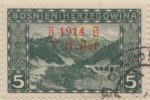 |
Small dot after 1914. | |
| Field №: 44 | Pane: N/A | ||
| Other nomenclatures: – | |||
| Notes: also on 10 heller stamp. | |||
| Value €: – | |||
| B. CONSTANT VARIETIES AND TYPES APPEARING ONLY ON ONE OF THE VALUES | |||
| 7 heller on 5 heller, dark green, overprint red | |||
| I | 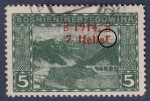 |
The letter “r” in “Heller” shifted upwards. | |
| Field №: 16 | Pane: N/A | ||
| Other nomenclatures: – | |||
| Notes: – | |||
| Value €: – | |||
| II |  |
Short 7. | |
| Field №: 36 | Pane: N/A | ||
| Other nomenclatures: – | |||
| Notes: – | |||
| Value €: – | |||
| III | 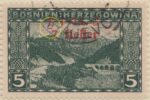 |
A mark below the lower left square. | |
| Field №: 40 | Pane: N/A | ||
| Other nomenclatures: – | |||
| Notes: – | |||
| Value €: – | |||
| IV | 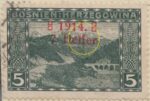 |
The second “l” in “Heller” is larger. | |
| Field №: 42 | Pane: N/A | ||
| Other nomenclatures: – | |||
| Notes: – | |||
| Value €: – | |||
| V |  |
The lower left square is damaged on the right. | |
| Field №: 48 | Pane: N/A | ||
| Other nomenclatures: – | |||
| Notes: – | |||
| Value €: – | |||
| VI |  |
Broken first “1”. | |
| Field №: 6 | Pane: N/A | ||
| Other nomenclatures: – | |||
| Notes: – | |||
| Value €: – | |||
| VII | 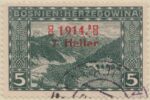 |
Cutaway Heller and printer’s block before the right squares. | |
| Field №: 10 | Pane: N/A | ||
| Other nomenclatures: – | |||
| Notes: also without printer’s block. | |||
| Value €: – | |||
| VIII | 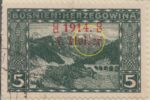 |
The second “l” in “Heller” is thin. | |
| Field №: 24 | Pane: N/A | ||
| Other nomenclatures: – | |||
| Notes: – | |||
| Value €: – | |||
| IX | 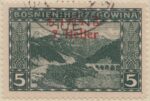 |
Dot after 1914 is missing. | |
| Field №: 30 | Pane: N/A | ||
| Other nomenclatures: – | |||
| Notes: – | |||
| Value €: – | |||
| X | 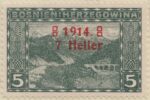 |
The first “1” in “1914” is thick. | |
| Field №: 32 | Pane: N/A | ||
| Other nomenclatures: – | |||
| Notes: – | |||
| Value €: – | |||
| XI |  |
The letter “r” in “Heller” is damaged. | |
| Field №: 33 | Pane: N/A | ||
| Other nomenclatures: – | |||
| Notes: – | |||
| Value €: – | |||
| 12 heller on 10 heller, carmine, overprint red | |||
| I | 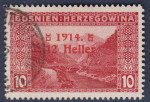 |
Damaged first row of the overprint. | |
| Field №: ? | Pane: N/A | ||
| Other nomenclatures: – | |||
| Notes: – | |||
| Value €: – | |||
| II |  |
A cut in the “1” in “12”. | |
| Field №: 6 | Pane: N/A | ||
| Other nomenclatures: – | |||
| Notes: – | |||
| Value €: – | |||
| III |  |
The lower left square is open on the right. | |
| Field №: 7 | Pane: N/A | ||
| Other nomenclatures: – | |||
| Notes: – | |||
| Value €: – | |||
| IV | 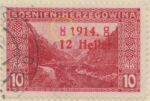 |
The upper left square is open on the top. | |
| Field №: 11 | Pane: N/A | ||
| Other nomenclatures: – | |||
| Notes: another example. | |||
| Value €: – | |||
| V |  |
Squares are positioned lower. | |
| Field №: 16 | Pane: N/A | ||
| Other nomenclatures: – | |||
| Notes: – | |||
| Value €: – | |||
| VI | 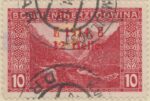 |
Broken base of the first “1” in “1914”. | |
| Field №: 21 | Pane: N/A | ||
| Other nomenclatures: – | |||
| Notes: – | |||
| Value €: – | |||
| VII | 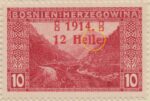 |
The second letter “l” in “Heller” is thick. | |
| Field №: 24 | Pane: N/A | ||
| Other nomenclatures: – | |||
| Notes: – | |||
| Value €: – | |||
| VIII |  |
Large 2. | |
| Field №: 25 | Pane: N/A | ||
| Other nomenclatures: – | |||
| Notes: – | |||
| Value €: – | |||
| IX |  |
Printer’s block before the left squares. | |
| Field №: 33 | Pane: N/A | ||
| Other nomenclatures: – | |||
| Notes: – | |||
| Value €: – | |||
| X | 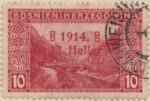 |
Dot after 1914 is set lower. | |
| Field №: 36 | Pane: N/A | ||
| Other nomenclatures: – | |||
| Notes: – | |||
| Value €: – | |||
| XI |  |
Small dot after 1914. | |
| Field №: 44 | Pane: N/A | ||
| Other nomenclatures: – | |||
| Notes: – | |||
| Value €: – | |||
| UNLISTED VARIETIES | ||
|---|---|---|
| 12 heller on 10 hellers, carmine, overprint red | ||
| 1 | The first “1” in “1914” thin. | 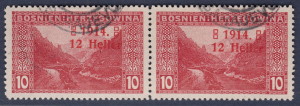 |
| 2 | Three types of number “2” in “12 Heller”. | 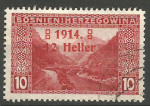 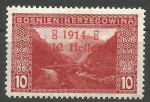 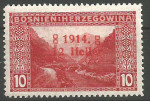 |
| COINCIDENTAL VARIETIES | ||
|---|---|---|
| 12 heller on 10 hellers, carmine, overprint red | ||
| A | Double overprint | 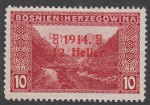 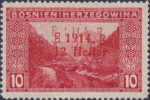 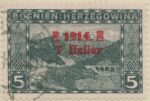 |
| B | Offset | 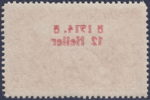  |
| C | Shifted overprint | 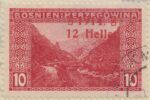 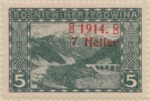 |
| D | Inverted overprint |  |
| E | Color smudge | 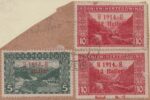 |
15 October 1915. The third war charity issue. Stamps with the effigy of Francis Joseph stamps, issued in 1912, overprinted with year mark 1915 in letterpress in red and blue colors. Printed in sheets of 100 (10 x 10).
| COINCIDENTAL VARIETIES | ||
|---|---|---|
| 7 heller on 5 heller, green, overprint red | ||
| A | Horizontally shifted overprint | 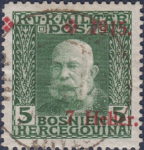 |
19 January 1916. The fourth war charity issue. Stamps with the effigy of Francis Joseph stamps, issued in 1912, overprinted with year mark 1916 in letterpress in red and blue colors. Printed in sheets of 100 (10 x 10).
| COINCIDENTAL VARIETIES | ||
|---|---|---|
| 1 | Horizontally shifted overprint | 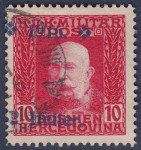 |
| 2 | Inverted overprint | 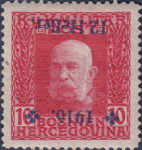 |
28 June 1917. Commemorative issue upon the third year from the assassination of Archduke Franz Ferdinand of Austria and his wife Sophia in Sarajevo. Designed by Cossmann, printed in letterpress, perforation 12½, 11½ and imperforate.
| UNLISTED VARIETIES | ||
|---|---|---|
| 15 heller + 2 hellers, claret | ||
| A | A scar on Archduke’s face. | 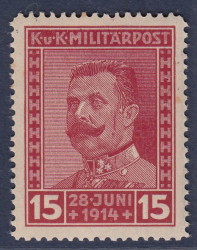 |
| COINCIDENTAL VARIETIES | ||
|---|---|---|
| 1 | Double impression |  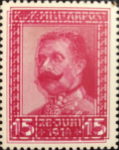  |
1 September 1918. Provisional issue. Stamps of 2 hellers from the Commemorative issue and 2 hellers from the first Francis Joseph issue overprinted with red overprint 1918 in letterpress.
Due to the increase of postage fees for postal stationery cards from 8 to 10 heller, there was a need for additional 2 heller stamps.
| Stamp | Circulation |
|---|---|
| 2 heller, violet | 100.000 (?) |
| 2 heller, light blue | 300.000 |
| SUSPICIOUS AND SPECULATIVE OVERPRINTS APPEARING ON BOTH VALUES | ||
|---|---|---|
| 1 | Inverted overprints. | 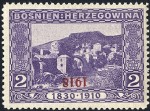 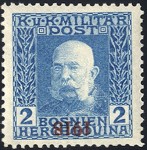 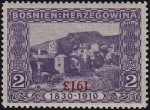 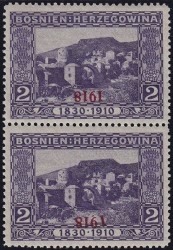 |
| 2 | Double overprints. | 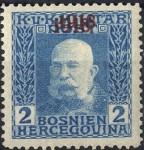 |
| 3 | Double head to tail overprints. | 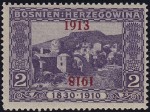 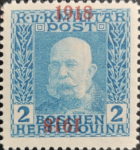 |
| COINCIDENTAL VARIETIES | ||
|---|---|---|
| A | Red smear on the left side (printer’s block). | 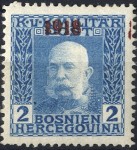 |
References
Bibliography
- Fleck, Vladimir (1941): Priručnik Maraka Hrvatskih Zemalja, Book 1, Tome 1, Hrvatski Filatelistički Savez, Zagreb
- Katalog poštanskih maraka jugoslovenskih zemalja (1991), Jugomarka (Belgrade). YU ISSN 0351-4447
Contributors
Some of the images on this page were contributed by mag. Boštjan Petauer FRPSL.

